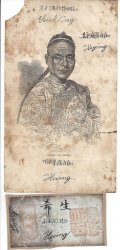
[Hesing Xi Cheng or Sheng, Captain of the Keying, Chinese Junk] Signed 8vo portrait drawing of Hesing, known as Xi Cheng. WITH
Signed `Hesing´ in bold black ink at the foot beneath his portrait, also adding the junk's name `Keying´ and the name `Suckling´ [not traced] to the portrait, all with their equivalent Chinese characters beneath. Quite heavily foxed, mainly around not on the image and signatures, top left corner torn off (a red ink stamp might have been there as in other examples, with Chinese characters, being the seal of Prince Hui Rui, but other examples would not have fitted in the lost corner). See image. WITH: Together with a colourful visiting card, c.9 x 5, a little worn with minor repair to corner, with Hesing signature, beneath his name in Chinese characters and alongside a Chinese ink red stamp, being the seal of Prince Hui Rui. Note: Hesing was a Mandarin who travelled in the Keying, first Chinese junk to ever sail from Hong Kong to New York and further to London. The Keying was a three-masted Chinese trading junk that sailed from Hong Kong in December 1846 with a mixed crew of Chinese and British sailors. The vessel had been purchased surreptitiously by a conglomerate of enterprising English businessmen. It was placed under the command of Captain Kellett with the intention of carrying curiosities and merchandise to England and thereafter serving as a kind of floating museum. The Chinese crew members that they were embarking on such an extended journey were not aware of such plans. The Keying arrived in New York City on July 9, 1847, creating a sensation, with seven thousand visitors per day. In late March 1848, the Keying arrived in London to great fanfare, and several different medals were struck to commemorate its appearance, including one that had a bust of Mandarin Hesing. It was visited by the Queen Victoria, whose right to be the first European woman to visit it was reserved, The Duke of Wellington and Charles Dickens. It has been suggested that the Chinese Emperor was aware of the project from the start and secretly kept informed about it, and that the mandarin served as an informer to report back in detail.


